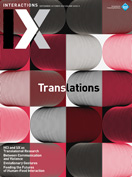Authors:
Ana Caraban, Evangelos Karapanos
Twelve years ago, Richard Thaler and and Cass Sunstein [1] introduced the notion of nudging. They defined a nudge as "any aspect of the choice architecture that alters people's behavior in a predictable way without forbidding any option or significantly changing their economic incentives." They suggested that nudging obeys the principle of libertarian paternalism, in that it preserves freedom of choice while at the same time ascribing to the belief that it is legitimate for choice architects to influence people's behaviors for their own good. Nudging has been applied successfully across a wide range of domains, including public policy,…
You must be a member of SIGCHI, a subscriber to ACM's Digital Library, or an interactions subscriber to read the full text of this article.
GET ACCESS
Join ACM SIGCHIIn addition to all of the professional benefits of being a SIGCHI member, members get full access to interactions online content and receive the print version of the magazine bimonthly.
Subscribe to the ACM Digital Library
Get access to all interactions content online and the entire archive of ACM publications dating back to 1954. (Please check with your institution to see if it already has a subscription.)
Subscribe to interactions
Get full access to interactions online content and receive the print version of the magazine bimonthly.






